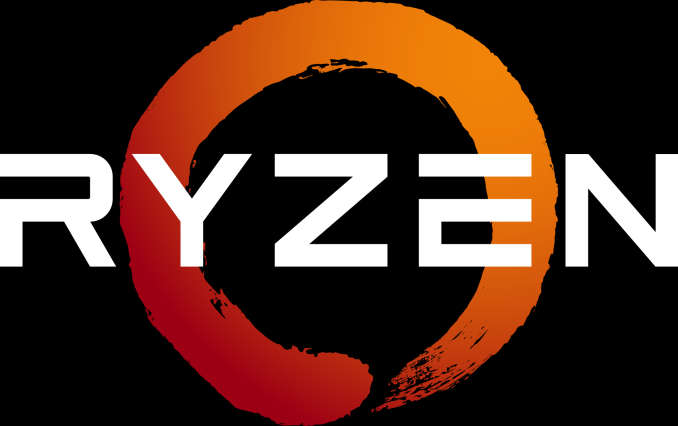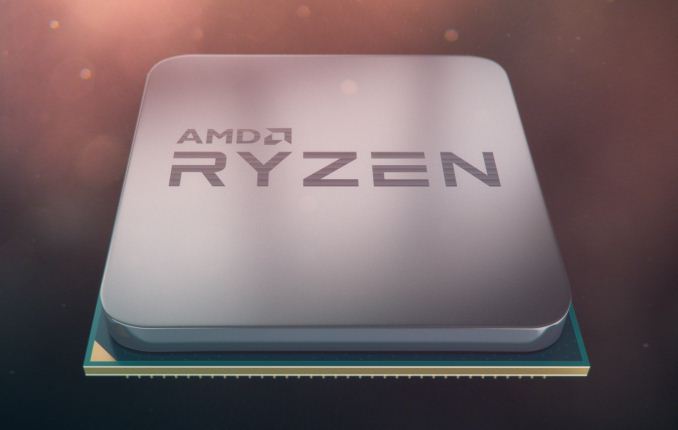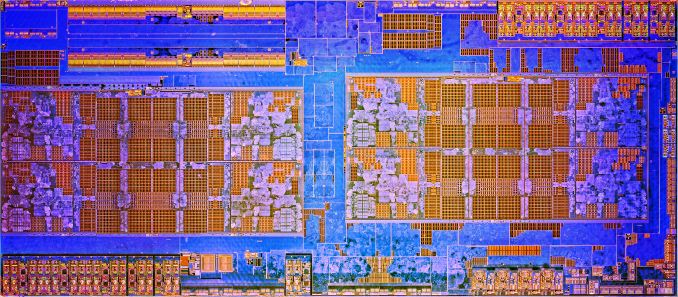AMD Launches Ryzen: 52% More IPC, Eight Cores for Under $330, Pre-order Today, On Sale March 2nd
by Ian Cutress on February 22, 2017 9:00 AM EST
The biggest x86 launch for AMD in five years is today: Ryzen is here. As always before a major launch, AMD gives a ‘Tech Day’ for relevant press and analysts, and through this event AMD’s CEO, Dr. Lisa Su lifted the lid on one of the most anticipated products in the semiconductor industry. AMD knows how to control the level of enthusiasm for its fans, and today is the end result, with processors going on pre-order from major retailers today at 1pm EST, ready for a general hard launch on March 2nd.
In a similar vein to launches of recent smartphones, AMD is doing a staggered announcement/launch with the products on their new microarchitecture. Where Samsung/Apple might give all the details for a product a few weeks before it’s available to buy, today on February 22nd marks the day where AMD is giving consumers information about Ryzen, and specifically the Ryzen 7 family of eight-core products. All the information today is from AMD, and AMD’s internal testing, and pre-orders also start from today for users ready to put down their money for a launch day part. Reviews of the CPUs, as well as when the CPUs will ship to customers, is on March 2nd. This also happens to be right in the middle of two annual shows, Game Developer Conference (GDC) and Mobile World Congress (MWC), making the time between receiving pre-launch samples and being able to provide independent verification of AMD’s performance claims relatively frantic. We’ll do our best!
The Ryzen Family
With a new processor launch, naming the parts and positioning them within the market is critical. So with Ryzen, the processor stack will be split into three based on performance and price: Ryzen 7 at the high end, Ryzen 5 in the middle, and Ryzen 3 for more price-conscious consumers. Both Ryzen 5 and Ryzen 3 are set to be launched later, and Ryzen 7 is the first portion of the family to be released.
Ryzen 7 will have three CPUs to start, all having eight cores and supporting simultaneous multi-threading:
- Ryzen 7 1800X: 8C/16T, 3.6 GHz base, 4.0 GHz turbo, 95W, $499
- Ryzen 7 1700X: 8C/16T, 3.4 GHz base, 3.8 GHz turbo, 95W, $399
- Ryzen 7 1700: 8C/16T, 3.0 GHz base, 3.7 GHz turbo, $329
Ryzen 7 1800X will be the high-end part, featuring a base clock of 3.6 GHz and a turbo of 4.0 GHz, within a TDP of 95W, and for $499. Next to this is Ryzen 7 1700X, launching at $399, with a base/turbo of 3.4/3.8 GHz. The final part for the launch is the Ryzen 7 1700, providing eight cores and sixteen threads for $329 at 3.0/3.7 GHz frequencies.
Processors will initially be available for pre-order from 185 retailers and OEMs worldwide, either as individual parts or pre-built systems.
What, not 40% IPC? 52% IPC??
Enthusiasts and analysts use the term IPC, or ‘Instructions Per Clock’, as a measure of how much the underlying microarchitecture improves from generation to generation. Two decades ago, a good design on a smaller node could net a healthy double-digit gain, whereas in recent years 5-10% gain has become the norm. When AMD initially announced that the new Zen microarchitecture they were developing was aiming for a 40% IPC gain, despite the low IPC they were starting from, users remained skeptical. AMD rehired Jim Keller to work alongside long-term AMD architect Mike Clark and produce a team with several goals in mind: high-performance x86, simultaneous multithreading, and a product to be relevant in the computing, PC, server and mobile space again. So despite this, 40% IPC always seemed a somewhat lofty goal, because Bulldozer was so underwhelming, and despite this low starting point. For the Ryzen launch today, AMD is stating that the final result of that goal is a 52% gain in IPC.
This is something we will need to test in due course!
The Ryzen Silicon, and the Future
AMD pointed out that the new 8-core silicon design runs 4.8 billion transistors and features 200m of wiring. Through previous announcements we’ve examined parts of the microarchitecture including cache sizes, threading, front-end/back-end design, and so on.
AMD Zen Microarchiture Part 2: Extracting Instruction-Level Parallelism
AMD Gives More Zen Details: Ryzen, 3.4 GHz+, NVMe, Neural Net Prediction, & 25 MHz Boost Steps
AMD’s CEO was keen to point out that this is a from-scratch design for AMD, using the knowledge gained from features developed for previous products but ultimately under the hood it looks like ‘a typical x86 high-performance core’, with AMD-specific features and tweaks. We were told that AMD’s roadmap extends into the multi-year range, so while the focus for 2017 will be on this family of products, back at HQ the next two generations are in various stages of development.
BENCHMARKS PLEASE
So despite the 82+ motherboards going to be available, 19 initial PC system builders moving into 200+ through the first half of 2017, the big question on everyone’s lips is how exactly does it perform?
Well, AMD gave us the following numbers:
AMD's benchmarks showed that the top Ryzen 7 1800X, compared to the 8-core Intel Core i7-6900K, both at out-of-the-box frequencies, gives an identical score on the single threaded test and a +9% in the multi-threaded test. AMD put this down to the way their multi-threading works over the Intel design. Also, the fact that the 1800X is half of the price of the i7-6900K.
In a similar vein, again with the Cinebench 15 multi-threaded test, the Ryzen 7 1700X scores over and above the Core i7-6800K (its price competition) and higher than the Core i7-6900K which costs 2.5 times as much.
We’ll tell you what our benchmarks say, with official retail processors. But you will have to wait until March 2nd. Sorry.





















386 Comments
View All Comments
Nagorak - Wednesday, February 22, 2017 - link
The thing is the R3 has 4 cores, whereas i3 only has 2 plus HT, so the R3 is a lot better. Even if you have to pay for a graphics card, you can buy a cheap graphics card for $20 if graphics performance is unimportant. Obviously AMD will want to get the APUs out to address those who just want a cheap all-in-one processor, but right now a lot of us don't even use the onboard graphics, ever...Aries1470 - Thursday, February 23, 2017 - link
"but right now a lot of us don't even use the onboard graphics, ever..."You mean home users, right?
Call centres and office workers, the majority use integrated graphics, as they do not need graphics, most are web based programs. Given the power usage scenario is the biggest issue, the issue will be with suppliers, of which Intel still holds the majority by their b*lls! That is where AMD's sales will primarily cone from, but, Intel will go back to their old self and no-obe will dare speak out, for a long time, unless the IT department specifically requests AMD and can't easily get hold of them from their traditional suppliers. So AMD's apu's will have a hard time getting a leg through the door.
I have even worked at places that had intel Atom's!! You only neefed to boot up, log in, get your few windows up and bam, ready for work! Nothing else allowed and worked actually ok.
thomasg - Saturday, February 25, 2017 - link
As a programmer and someone who compiles a lot of software, it's pretty clear to me, that the opposite is the case.Yeah, the Intel GPUs certainly are sufficient, but buying the fastest Intel Quadcore with a integrated GPU will give you a _much_ slower CPU than buying a Ryzen (assuming the promises hold up), and sticking in a < USD 50 dGPU with it's own ram means you don't have penalties from the iGPU while still spending a _lot_ less on the whole system. Fair enough, power consumption will be slightly higher, but who cares when the CPU is doing a lot of compiling at full power?
Even more, if you're going up a tier to the 8-core CPUs, which a lot of programmes really love to have, Intel doesn't have the iGPU anymore, and you'll spend about twice the money for twice the same performance.
So yeah, a dGPU will cut in the savings a bit for budget programer systems, but the difference appears to be so large, that you'll still save a lot of money.
So clearly, if you're a programmer wanting a beefy CPU, there is no reason whatsoever to consider Intel if everything holds up as promised. The iGPU certainly isn't one.
stockolicious - Wednesday, February 22, 2017 - link
I think you hit the nail on the head.lilmoe - Wednesday, February 22, 2017 - link
Same to a little faster performance for half the price? For me, Intel is dead bro. They took too much of my money already, not anymore.Lolimaster - Wednesday, February 22, 2017 - link
Half the price on their worse price/performance chip, most of the times is 2.5-3x as cheap.lilmoe - Wednesday, February 22, 2017 - link
And at those, AMD has even cheaper AND faster processors... AMD still hasn't introduced their integrated GPU SKUs. I can vouch for their GPUs over Intel's in both performance and drivers. It's only a matter of time before Intel silicon makes little to no sense.This isn't only about the desktop. Intel has lost BIG in mobile. With Windows on ARM getting ready for debute, I'm not sure where Intel is going to stand.
If I had Intel stock I'd sell.
The_Assimilator - Thursday, February 23, 2017 - link
Only someone who incorrectly believes Intel is a CPU-only company would sell their stock.medi03 - Wednesday, February 22, 2017 - link
If we are lucky AMD will get so much needed market share income and will be able to bring competition to both GPU and CPU markets.Krysto - Wednesday, February 22, 2017 - link
It was smart of them to go with the PC lineup first, to show that they can beat "Intel's best".But with Intel starting to focus on servers first, AMD could make a killing by focusing on laptops first. Next year's generation should really come out on the notebook first and wipe out Intel from the notebook market. But they need to do it soon, before Intel moves to 10nm, because then it will get a bit harder, even if AMD will continue to have the performance/price advantage. And AMD won't switch to 7nm (I think directly from 14nm) until late 2019 probably. But it will be a good time to switch before Intel gets a chance to do it.